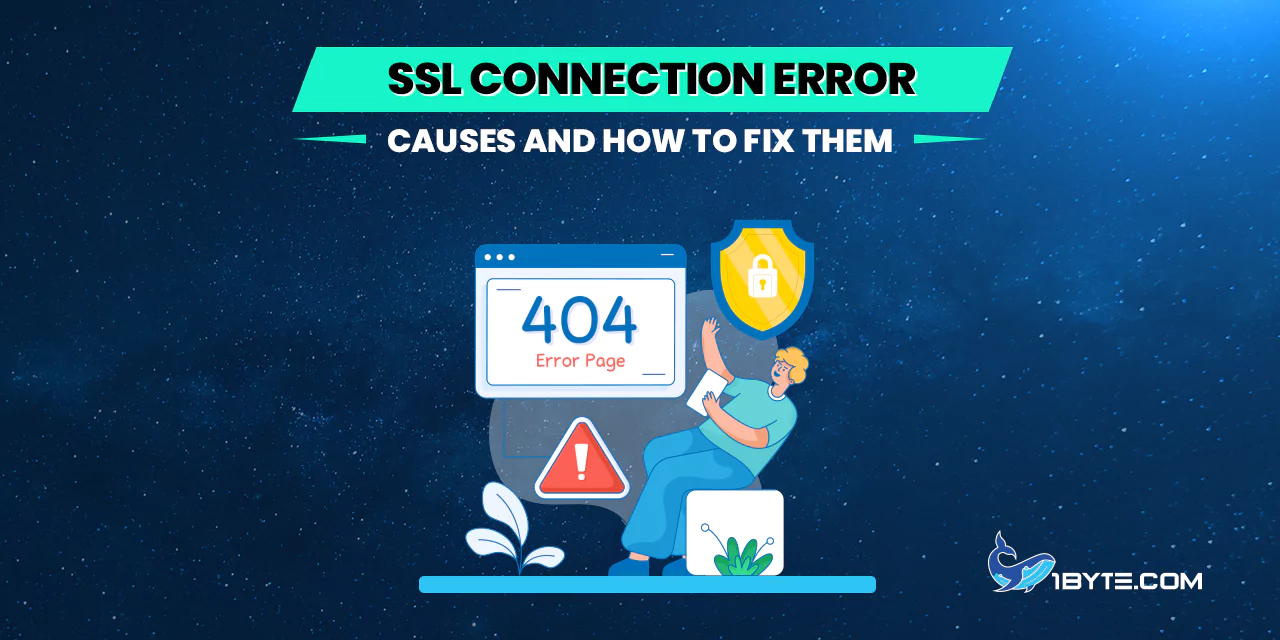It is rather irritating to come across an SSL connection error. This error denies users the ability to browse the internet securely. It can happen for many causes. It is important for users as well as website owners to know these causes.
Current statistics reveal that connection errors of SSL are often. Such mistakes can turn people off from the websites. This goes to show that SSL problems need to be dealt with as soon as they are identified.
These points are best explained with the help of examples, which will be laid out in the following article from 1Byte.
Common Causes of SSL Connection Errors
SSL connection errors are some of the most familiar problems that many users experience. These errors can break the secure communication between a user’s browser and a site. It is therefore important to understand the common causes of SSL connection errors so as to be able to solve them.
Expired SSL Certificates
One of the main reasons for SSL connection errors is expired SSL certificates. When an SSL certificate expires, the browser cannot authenticate the website and this leads to the display of the warning message. This leads to an SSL connection error.
Current data reveal that the majority of organizations suffer from unexpected downtime caused by expired certificates. Such outages can cause serious disruptions of services and affect a large number of users. For instance, GitHub and Spotify suffered severe outages as a result of expired SSL certificates.
Other issues include expired SSL certificates that are also a security concern. They make websites open to attacks. This leads to high possibilities of data leakage and loss of customer confidence.
To prevent them, SSL certificates must be managed effectively and not be left to cause havoc when they expire. Maintaining a record of all the certificates is useful in tracking their expiry dates. It is important to renew certificates before they expire so as to avoid disruptions in service. There are tools for this purpose, for example, ServiceNow’s Certificate Inventory and Management solution.
Mismatched Domain Names
One of the most frequent reasons for an SSL connection error is the conflict of domain names. This happens when the domain name on the SSL certificate is different from the domain name displayed on the browser’s address bar. For instance, if the certificate is issued for www.example.com but the user visits example.com, an error will occur.

This can result in a drastic reduction of trust and sales for companies in the market to consumers. This is because when users are faced with an SSL error they are likely to abandon the site and this will influence the bounce rate of the site.
For this problem, website owners should make sure that the SSL certificates they have are valid for all the domains that are related to the website. This is the case of www and non-www versions and other subdomains if any. If you want to secure multiple domain names, it is possible with the help of a wildcard certificate or multi-domain certificate.
For example, a wildcard certificate is *.example.com will cover www.example.com, blog.example.com, or any other subdomains. This helps to avoid cases whereby the user is faced with an SSL connection error because the domain names do not match.
Untrusted Certificate Authority
An untrusted certificate authority is one of the most frequent reasons for SSL connection problems. If a browser comes across an SSL certificate issued by an unknown CA, then it will show a message that the connection is not secure.
Web browsers rely on a few CAs only. These trusted CAs are subjected to several validation procedures. If an SSL certificate is obtained from an untrusted CA, the browser cannot authenticate it and hence results to an SSL connection error.
For example, self-signed certificates are untrusted most of the time. They are issued by the same organization that gives them out, and therefore they do not pass through the validation of a trusted CA. For this reason, browsers mark them as untrusted.
The major problem of using a self-signed certificate is that these certificates are not trusted by the most popular browsers. This results in a loss of trust and traffic for websites.
To overcome this problem, it is recommended to get SSL certificates from reputed CAs like DigiCert and Let’s Encrypt which are accepted by all browsers. Websites that have SSL certificates from trusted CA are more trusted by the users.
Incorrect System Time
A wrong system time is one of the leading causes of SSL connection errors. There are cases when the system clock is not accurate and therefore, SSL certificates may look fake. This is because SSL certificates have certain validity periods. If the system time is out of this range then the certificate is considered as expired or not yet valid.
One of the examples was a particular user who was locked out of a secure site because of an SSL connection error. On investigation it was observed that the system clock was set to a date prior to two years. Changing the system time helped to fix the problem on the spot.
To rectify this issue, the users should make sure that their system clock is properly synchronized. This can be done by syncing the device with an internet time server, for instance. Almost all operating systems have options that allow the system time to be updated on its own. For example, in Windows, the users can click on the Settings > Time & Language > Date & Time and turn on the option that allows changing the time automatically.
How to Fix SSL Connection Errors
In this section, we will talk in detail about how to fix certain crucial SSL connection errors.
Renew or Replace Expired Certificates
An example of a problem that can result from expired SSL certificates is an ssl connection error. This error affects the secure connection between the user’s browser and the website being used. To rectify this, one has to renew or replace the expired certificates as soon as possible.
To renew an SSL certificate, one has to increase the time period for which the certificate is valid. Many CAs provide notifications on the certificate expiration date or before the date in question. It also prevents the connections from being compromised, which is proactive in nature.
In some cases, it becomes necessary to replace an SSL certificate. This could be due to change of domain name or change of CA that the domain belongs to. For instance, a website migrating from HTTP to HTTPS will require a new SSL certificate.
Below are steps to renew or replace expired certificates:
- Identify the Expired Certificate: For instance, one can use SSL Labs to check the status of the certificate.
- Choose a Certificate Authority: Choose a reliable CA for renewal or replacement.
- Generate a Certificate Signing Request (CSR): This is very important for one to get a new certificate.
- Install the New Certificate: Read the CA’s instructions on how to install the renewed or replaced certificate.
It is important to check the SSL certificates from time to time and renew them before they expire. It makes sure that there are secure connections always and there are no ssl connection errors.
Ensure Domain Name Matches
One of the most common reasons for the SSL connection error is the domain name on the SSL certificate and the domain name that is being used do not match. This problem may arise when the SSL certificate is installed for a different domain or subdomain. For instance, if the certificate is for www.example.com but the user accesses example.com, an error will appear.

To rectify this, make sure that the domain name in the SSL certificate is the same domain name that the users are using. Domain mismatches which are also known as protocol-relative URLs are identified to be among the major SSL connection errors.
Website administrators should verify SSL certificate details. They can do this by clicking the padlock icon in the browser’s address bar. This action will show the certificate details and among them will be the domain name. If there is a mismatch then the administrator should get in touch with the certificate issuing authority to obtain the certificate with the correct domain name.
Use Trusted Certificate Authorities
Another way to solve the SSL connection errors is to use trusted Certificate Authorities (CAs). Trusted CAs are the companies that check the authenticity of the web site. They issue SSL certificates that browsers consider as secure. This helps avoid the common SSL connection errors.
For instance, SSL Labs’ research established that websites with certificates from unknown CAs experienced higher SSL connection errors. This goes to show why there is a need for trusted CAs. The following are some of the ways through which these errors can be reduced: Employing well-known CAs such as DigiCert, GlobalSign, and Let’s Encrypt.
Furthermore, Google Chrome and other browsers mark the sites with untrusted certificates. This may discourage users from visiting the site. Thus, the utilization of reliable CAs not only solves the SSL connection problems but also improves the users’ confidence and website reputation.
Check and Correct System Time
Discrepancy in system time can lead to SSL connection problems. Today, browsers use system time to check SSL certificates, which means that the manipulation with the time can lead to the certificates’ validation. If the system time is not correct then the browser will consider the certificate as expired or not even valid yet.
To fix this, follow these steps:
- Check System Time: Check the time on the system clock. Make sure that it has the right date and time displayed on it. If it doesn’t, go to the next step.
- Adjust System Time: Navigate to the settings of the system. Locate the date and time settings. Switch on the option to synchronize time automatically. This will set the system time to an internet time server to ensure that the system time is correct.
- Manual Adjustment: If automatic setting fails, then one has to set the time manually. Please, input the correct date and time. Make sure the time zone is also correct as well.
- Restart Browser: Refresh the browser by clicking on the ‘X’ button and reopening the browser. This makes the changes effective.
Leverage 1Byte’s strong cloud computing expertise to boost your business in a big way
1Byte provides complete domain registration services that include dedicated support staff, educated customer care, reasonable costs, as well as a domain price search tool.
Elevate your online security with 1Byte's SSL Service. Unparalleled protection, seamless integration, and peace of mind for your digital journey.
No matter the cloud server package you pick, you can rely on 1Byte for dependability, privacy, security, and a stress-free experience that is essential for successful businesses.
Choosing us as your shared hosting provider allows you to get excellent value for your money while enjoying the same level of quality and functionality as more expensive options.
Through highly flexible programs, 1Byte's cutting-edge cloud hosting gives great solutions to small and medium-sized businesses faster, more securely, and at reduced costs.
Stay ahead of the competition with 1Byte's innovative WordPress hosting services. Our feature-rich plans and unmatched reliability ensure your website stands out and delivers an unforgettable user experience.
As an official AWS Partner, one of our primary responsibilities is to assist businesses in modernizing their operations and make the most of their journeys to the cloud with AWS.
Conclusion
In conclusion, it is vital to know and address an SSL connection error in order to have a secure connection on the Internet. According to the latest statistics, more than 40% of the sites experience SSL problems every year. This goes to show that these errors should be corrected as soon as possible.

